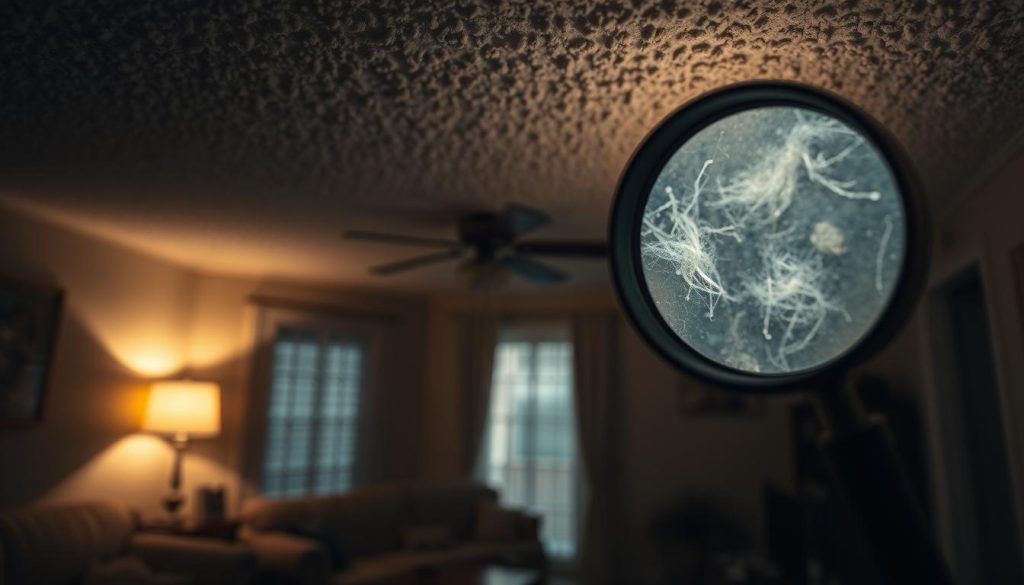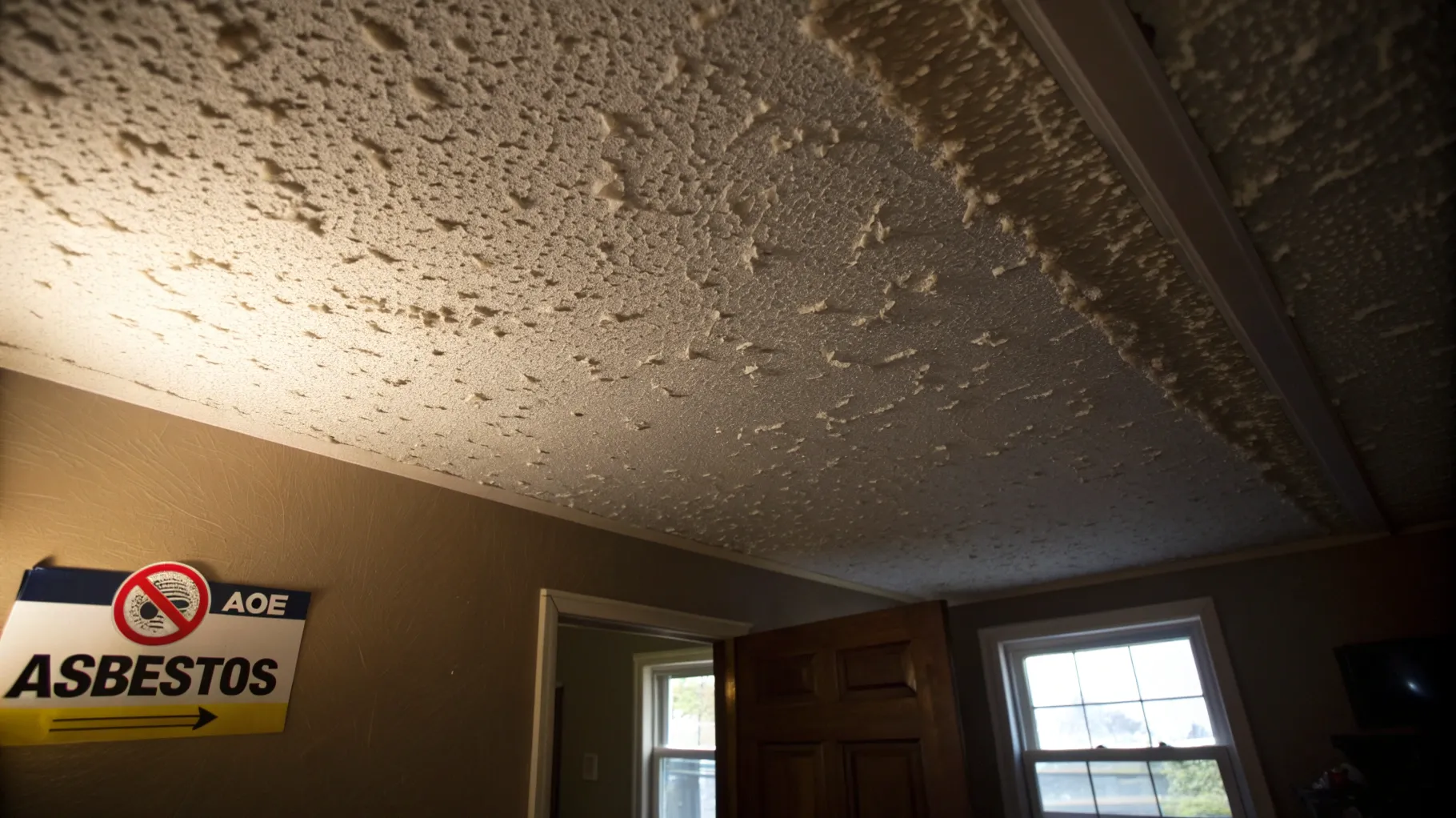Table of Contents
Did you know over 30 million homes in the U.S. might still have popcorn ceilings? Many were installed before the late 1970s, when asbestos was common. This texture looks like fluffy popcorn but hides serious risks. Popcorn ceilings can be harmful because they may contain asbestos, a dangerous material.
Asbestos is linked to severe respiratory problems and diseases. In this article, we’ll look into why popcorn ceilings are bad. We’ll also talk about the dangers of asbestos exposure. This will help you understand the risks of having these ceilings in your home.
Key Takeaways
- Over 30 million homes in the U.S. feature popcorn ceilings.
- Many popcorn ceilings may contain hazardous asbestos.
- Asbestos exposure is linked to serious health risks.
- It’s crucial to assess the safety of your popcorn ceilings.
- Understanding these risks can help protect your health.
Understanding Popcorn Ceilings
Popcorn ceilings, also known as acoustic or textured ceilings, were a hit in the mid-20th century. They were loved for their unique look and practical uses. Knowing about these ceilings is key for anyone thinking about their looks or safety.
What Are Popcorn Ceilings?
Popcorn ceilings have a bumpy, irregular surface. They’re made by spraying a special material onto the ceiling. This texture adds interest to a room and helps with sound.
They were great for making rooms quieter, which was a big plus in places like apartments.
Why Were They Popular?
Popcorn ceilings were all the rage from the 1950s to the 1980s. Several reasons made them so popular:
- They were affordable to install and update.
- They hid imperfections in the drywall.
- They were marketed as an easy way to get a modern look.
- They fit with the post-war focus on cost and efficiency.
Health Concerns Associated with Asbestos
Asbestos is harmful and poses serious health risks. Knowing about asbestos helps people make better choices about their surroundings.
What is Asbestos?
Asbestos is a group of minerals that resist heat and insulate well. It was widely used in construction and industries for years. Now, people are more aware of its dangers and how it affects health.
Health Risks of Asbestos Exposure
Being exposed to asbestos can cause serious health problems. When you breathe in asbestos fibers, it can harm your lungs. Even a little exposure can lead to lung cancer and mesothelioma, which are very dangerous.
Asbestos-Related Diseases
Asbestos is linked to serious diseases. Asbestosis, lung cancer, and mesothelioma are just a few. These diseases can change a person’s life forever. It’s crucial to be careful and aware of asbestos in your environment.
Why Are Popcorn Ceilings Bad

Popcorn ceilings are common in homes built before the 1980s. They might contain asbestos, which is a big concern. Homeowners should know the risks before starting any renovations.
Asbestos Content in Popcorn Ceilings
Older homes often have popcorn ceilings with asbestos. Poor maintenance or damage can release asbestos into the air. It’s important to check for asbestos before starting any work.
Potential for Airborne Asbestos Fibers
When popcorn ceilings are touched, it can be dangerous. Scraping or drilling can send asbestos fibers flying. These tiny particles can stay in the air, putting people’s health at risk. It’s crucial to be careful around these ceilings.
Identifying Asbestos in Your Home

Homeowners should know about asbestos, mainly if they have popcorn ceilings. Finding asbestos needs careful look and professional tests for safety.
Signs of Asbestos in Popcorn Ceilings
Look for signs of asbestos in popcorn ceilings. If your home was built before the mid-1980s, it might have asbestos. Also, check the ceiling’s texture. Popcorn ceilings are usually rough and bumpy.
If the ceiling is crumbling or deteriorating, fix it quickly. This is very important.
How to Test for Asbestos
Testing for asbestos should be done by trained professionals. A licensed asbestos abatement professional can take samples and test them. This confirms if your ceiling has asbestos.
Don’t try to test it yourself. It’s risky and could harm your health.
Understanding Ceiling Textures
Knowing different ceiling textures helps you tell popcorn ceilings from newer ones. Popcorn ceilings feel rough, while newer ones are smoother. Knowing this helps you check your ceilings.
Popcorn Ceiling Removal Process

Removing popcorn ceilings can be tough, mainly because of asbestos. It’s important to follow a safe and detailed removal process. Knowing the steps helps homeowners decide if they should do it themselves or hire professionals.
Steps to Safely Remove Popcorn Ceilings
The popcorn ceiling removal process has several key steps:
- Assess the Ceiling: First, test the ceiling for asbestos, which is common in older homes.
- Prepare the Area: Move furniture out and cover the floor and walls with plastic to prevent mess.
- Personal Protective Equipment (PPE): Wear masks, gloves, and goggles to stay safe from asbestos.
- Moisten the Ceiling: Spray the ceiling with water to help scrape off the popcorn texture without dust.
- Remove the Texture: Gently scrape off the popcorn and collect the debris for safe disposal.
- Dispose of Materials: Follow local rules for disposing of asbestos or popcorn ceiling debris.
DIY vs. Hiring Professionals
Doing it yourself might seem cheaper, but it’s risky with asbestos. Professionals have the right training and tools for safe removal. They follow all safety rules, making the job safer and less stressful.
Comparison of DIY and Professional Removal
| Aspect | DIY Removal | Professional Removal |
|---|---|---|
| Cost | Lower upfront costs | Higher costs but includes safety measures |
| Safety | Higher risk of asbestos exposure | Trained to manage asbestos safely |
| Time | May take longer due to inexperience | Typically faster with experienced teams |
| Compliance | Potential for non-compliance with safety regulations | Adheres to local and federal regulations |
Also Read: How Much Does Landscaping Cost? Discover Shocking Price Secrets!
Mitigating the Risks of Asbestos
Homeowners can take steps to reduce risks from asbestos in popcorn ceilings. One good method is encapsulation. This seals the asbestos, stopping harmful fibers from spreading in the air. It’s key during home renovations, when moving things around can stir up asbestos.
Before starting any renovation, it’s crucial to check for asbestos. Regular checks and monitoring of ceilings can keep everyone safe. Following asbestos abatement rules is also important to handle any dangers well.
Knowing how to handle asbestos is key to keeping homes safe and healthy. By being careful and informed, homeowners can make their homes safer. This reduces the risk of asbestos-related health problems.

